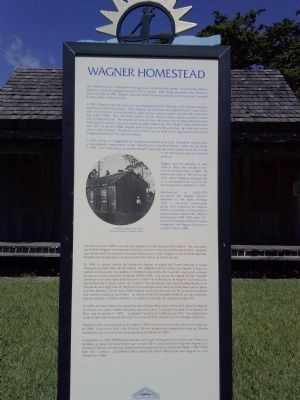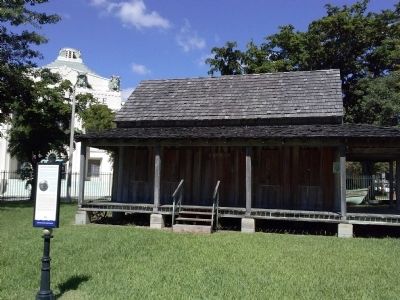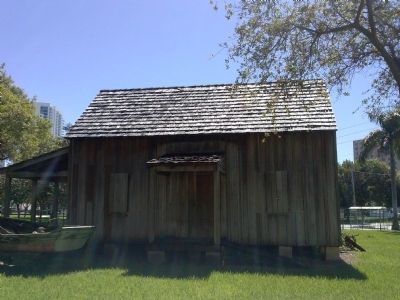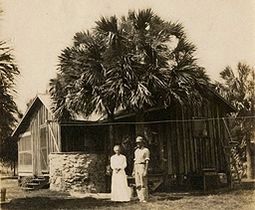Miami in Miami-Dade County, Florida — The American South (South Atlantic)
Wagner Homestead
Miami River Greenway
In 1855, Wagner's former Army unit was assigned from Fort Moultrie to Fort Dallas along the north shore of the Miami River. There, Wagner joined forces with Captain Sinclair, a sea captain with two schooners, and established a sutler's store to serve troops during the Third Seminole War (1855-1858). With help from Captain Sinclair, Wagner built a steam-powered coontie mill on Wagner Creek. The production of starch from the native coontie plant (Zamia pumila) which grew profusely in the pine woods became a means by which Miami's early settlers could earn cash. In the late 1850s, Wagner built a house nearly 50 yards from the creek that would come to bear his name. The Dade County pine house is a hand-hewn, peg-fastened and wood shingled example of 19th century shelters.
In 1875, acting on a suggestion by the Reverend Bishop Verot of St. Augustine, Wagner built a small Catholic chapel known as the "Little Church in the Pine Woods," which burned down in 1892. The "Little Church in the Pine Woods" was regarded as the earliest house of worship in the Miami area since the Spanish missions.
Wagner sold his property to Julia Tuttle in 1893, then bought it back from the probate court in 1899. He died on the land in 1901 at the age of 76. William Wagner was regarded as a true pioneer who lived to see the incorporation of Miami in 1896.
Development in 1920-1970 prompted the Wagner Homes donation to the Dade Heritage Trust, a non-profit preservation group who undertook the Wagner Homes' restoration and relocation to Lummus Park, named after Miami's third mayor (1900-1903) John "J.E." Lummus. The Miami City Commission designated the Wagner Homestead a historic site in 1984.
Caption:
Catholic chapel circa 1890 Historical Museum of South Florida
Erected by Dade Heritage Trust and the Villagers.
Topics. This historical marker is listed in these topic lists: Agriculture • Settlements & Settlers • War, Mexican-American • Wars, US Indian. A significant historical year for this entry is 1847.
Location. 25° 46.587′ N, 80° 12.136′ W. Marker is in Miami, Florida, in Miami-Dade County. Marker can be reached from the intersection of Northwest North River Drive and Northwest 3rd Street, on the right when traveling north. The Wagner Homestead and marker are located
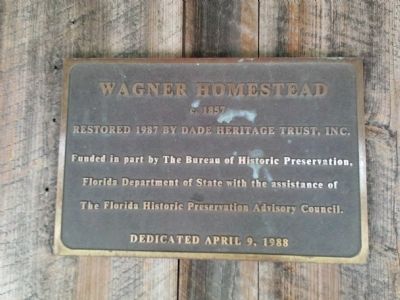
Photographed By Marsha A. Matson, October 19, 2014
2. Wagner Homestead Marker at door of house
Wagner Homestead
1857
Restored 1987 by Dade Heritage Trust, Inc.
Funded in part by The Bureau of Historic Preservation, Florida Department of State with the assistance of The Florida Historic Preservation Advisory Council. Dedicated April 9, 1988.
Other nearby markers. At least 8 other markers are within walking distance of this marker. Fort Dallas and the William F. English Plantation Slave Quarters (within shouting distance of this marker); Lummus Park Historic District (about 600 feet away, measured in a direct line); South River Drive Historic District Boarding Houses (approx. ¼ mile away); Miami River Historic Working Riverfront (approx. ¼ mile away); Dade County (approx. half a mile away); The Historic Negro Police Precinct & Courthouse Museum: The First Five (approx. half a mile away); Judge Lawson Edward Thomas Law Office (approx. 0.6 miles away); Gesu Catholic Church (approx. 0.6 miles away). Touch for a list and map of all markers in Miami.
Also see . . .
1. William Wagner House. City of Miami Planning Department (Submitted on October 22, 2014.)
2. William Wagner House Designation Report (pdf file). City of Miami: Historic Preservation (Submitted on October 22, 2014.)
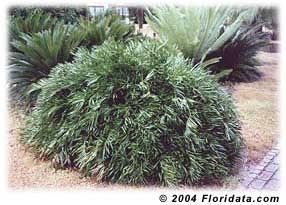
Photographed By Floridata.com, 2004
6. Wagner Homestead Marker
Exerpt from Floridata.com - Florida's indigenous peoples and later European settlers processed the coontie's large storage root to extract an edible starch. For this reason the coontie was often commonly called Seminole bread during the late 1800s.
Credits. This page was last revised on January 25, 2018. It was originally submitted on October 21, 2014, by Marsha A. Matson of Palmetto Bay, Florida. This page has been viewed 772 times since then and 39 times this year. Photos: 1, 2, 3, 4, 5, 6. submitted on October 21, 2014, by Marsha A. Matson of Palmetto Bay, Florida. • Bernard Fisher was the editor who published this page.
